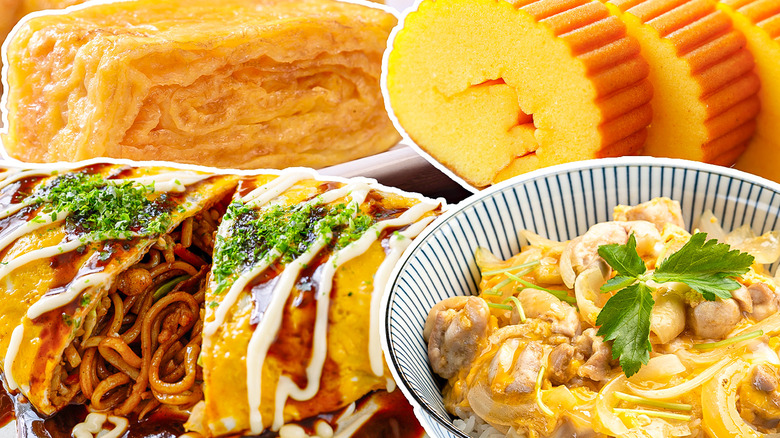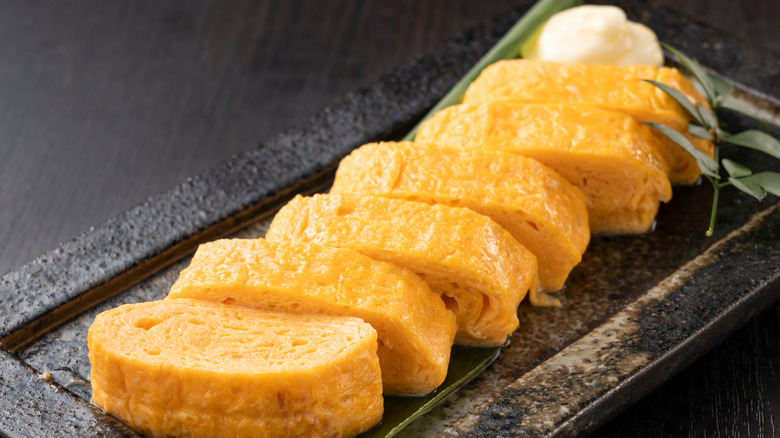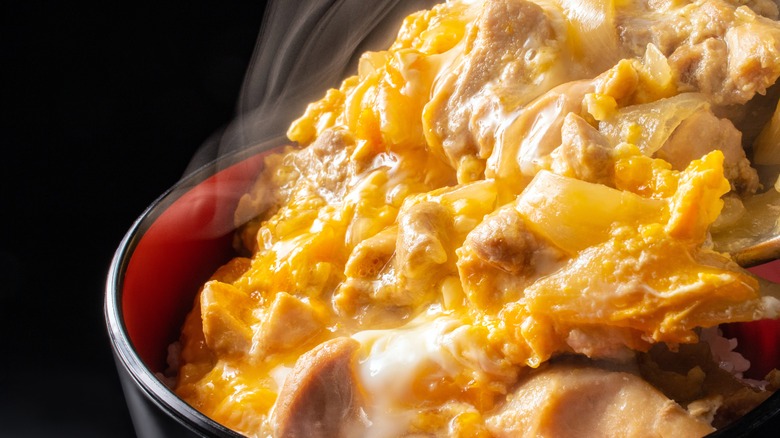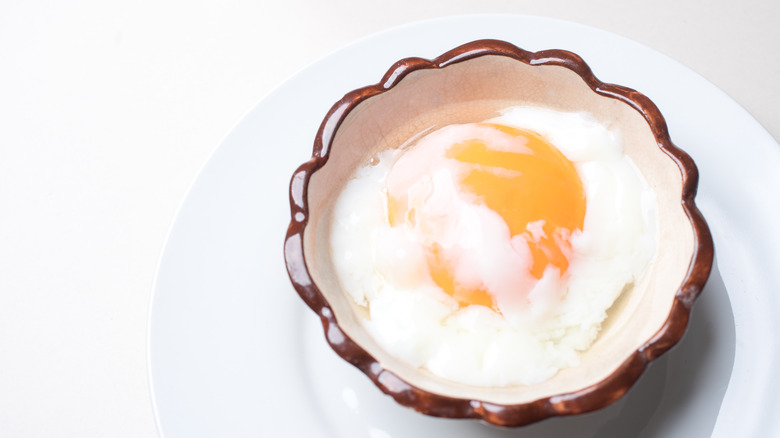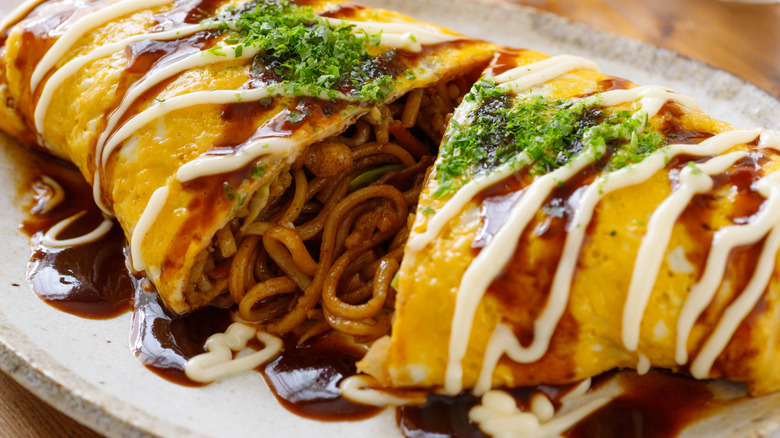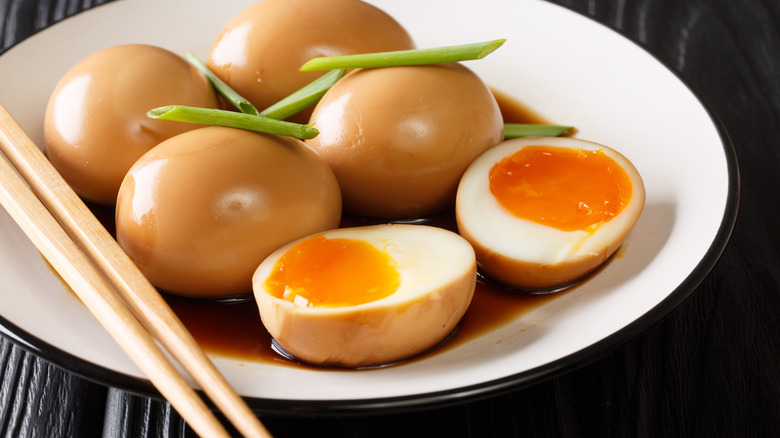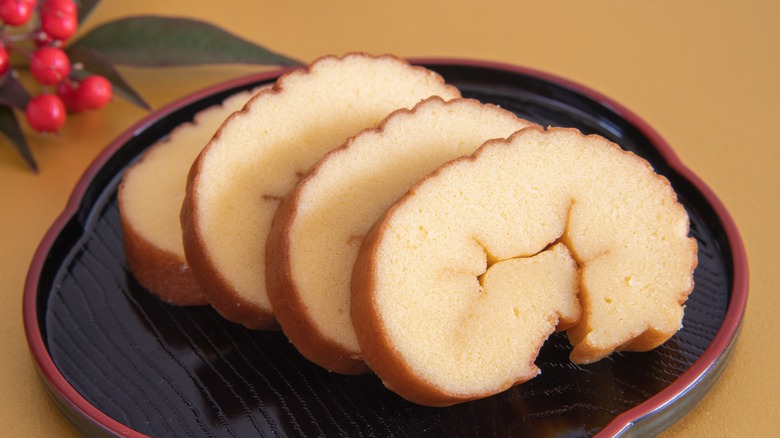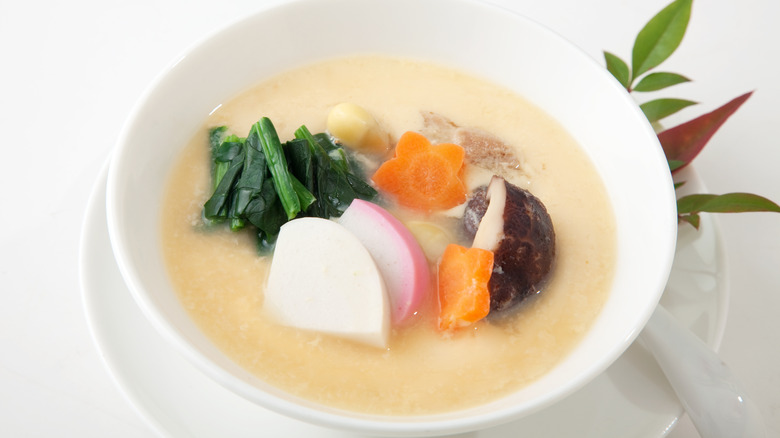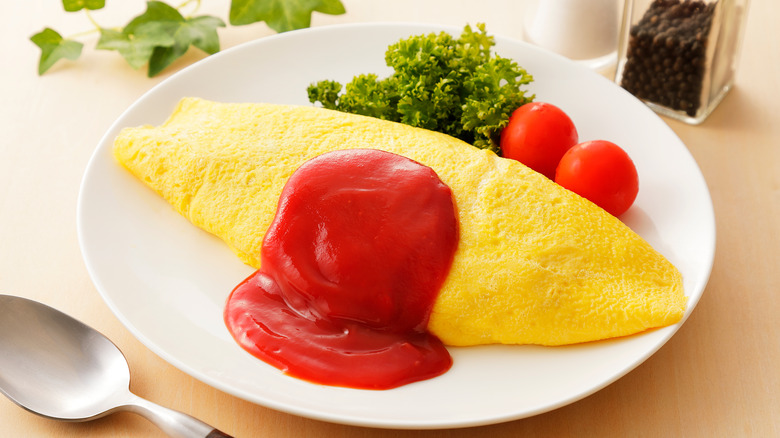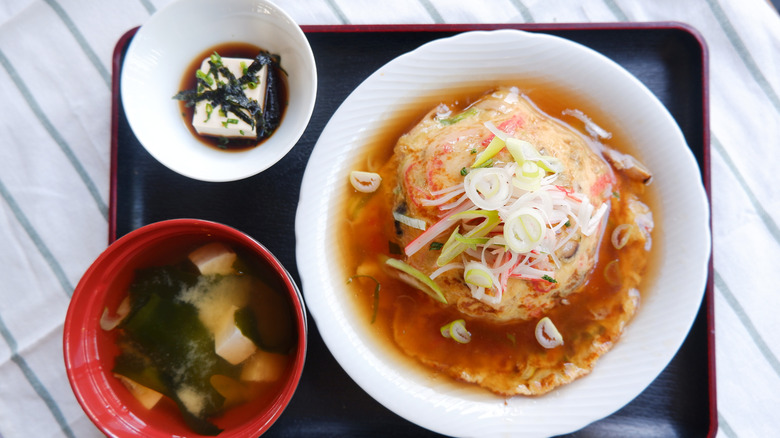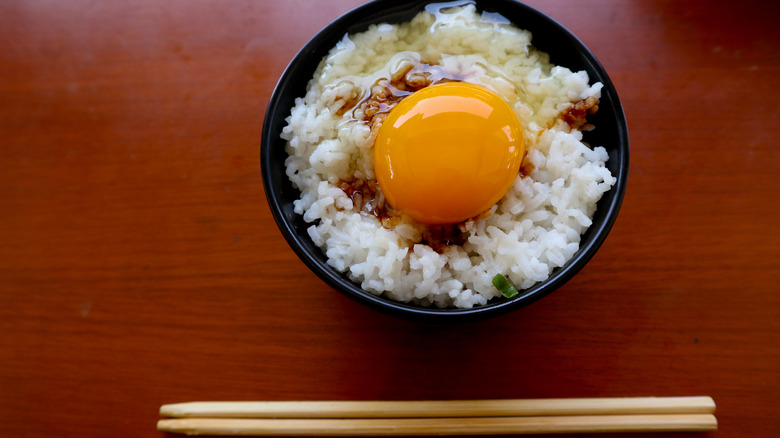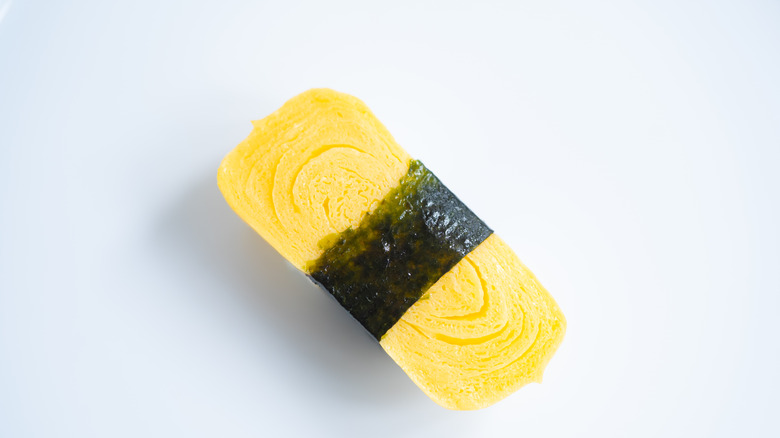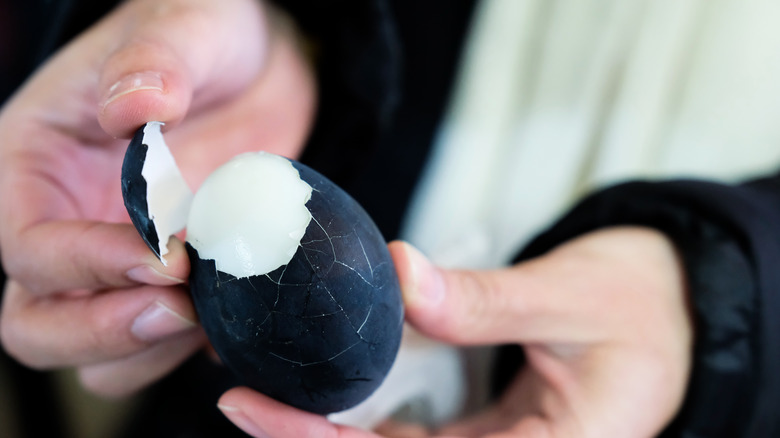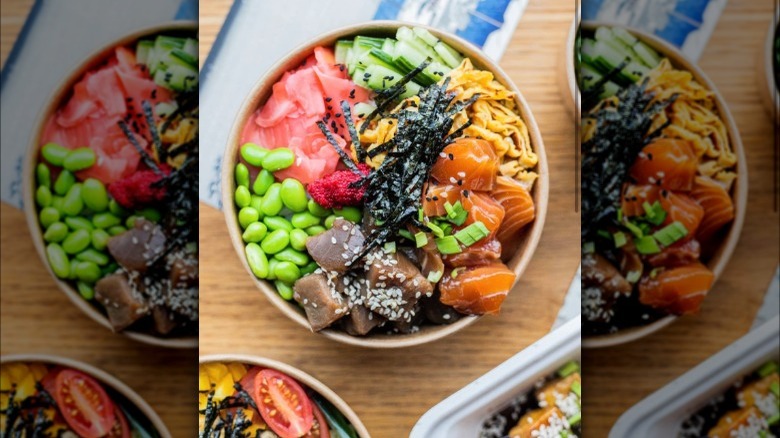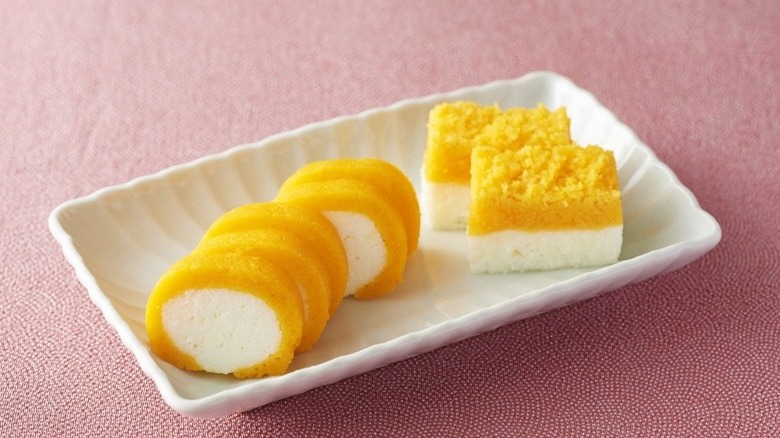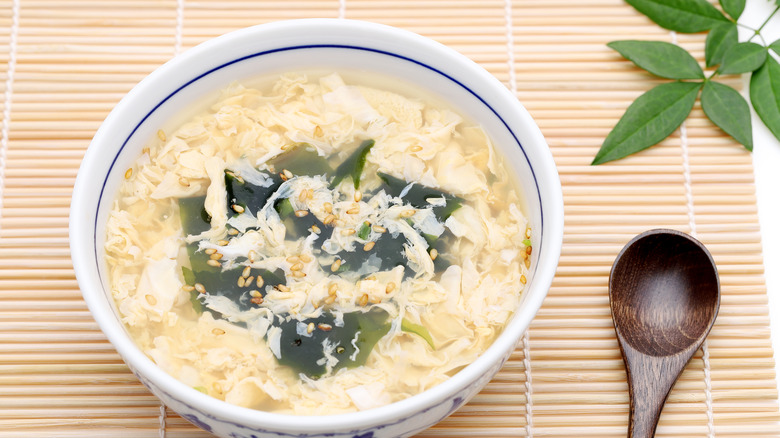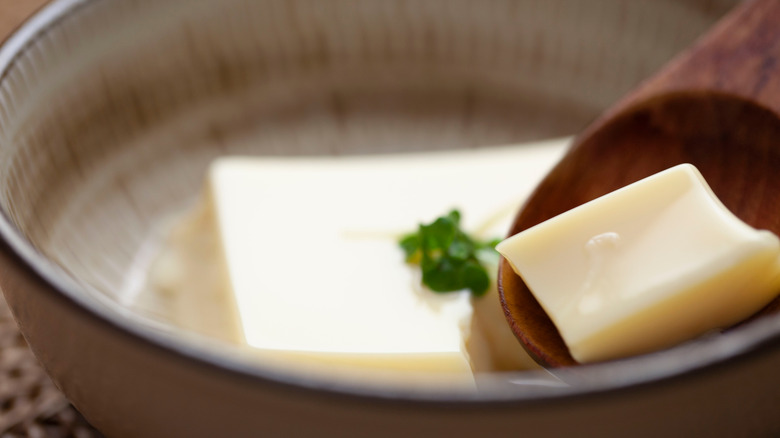16 Egg Dishes From Japan You Need To Try At Least Once
Japan is a country with a diverse culinary landscape, which makes it a popular travel destination for tourists and foodies from around the world. You won't have to travel very far to sample a medley of authentic Japanese dishes like takoyaki, fried octopus balls served with sauce, Japanese mayonnaise, and bonito flakes, or shabu-shabu hot pot. Although many of the ingredients that frequently surface in Japanese food include soy, miso, fish, and beef, eggs also play a major role in some of the country's favorite dishes.
According to data published by the International Egg Commission, the average person in Japan consumed 337 eggs in 2018, compared with the global average of around 161 eggs per year. The popularity of eggs in the country is linked to their nutritional benefits and relatively inexpensive price compared to other proteins. You'll find eggs as a garnish in dishes like ramen but also as the star of several dishes prepared on the island. Here are some of the Japanese egg dishes you need to try.
Tamagoyaki
Tamagoyaki is a Japanese rolled omelet that combines egg flavored with sake, mirin, and dashi. The exact ratio of these ingredients depends on personal preference and may also include chopped scallions for texture. The dish's name is broken down into "tamago," which means egg, while "yaki" translates to grill. The omelet is served for breakfast, in a bento box for lunch, or alongside sushi.
Although the tamagoyaki's intricate design makes it look like a difficult dish, it is a relatively easy omelet with a little practice and a couple of YouTube videos. The tamagoyaki is made by pouring a thin layer of egg on the bottom of a special pan and rolling it back and forth until it forms soft, delicate layers and a rolled, log-shape appearance.
Oyakodon
Oyakadon, or Oykao Donburi, is a rice bowl with chicken, egg, and an umami-rich dashi broth. The egg and chicken are cooked first before being poured over the rice and served. The dish's name translates to "parent-child rice bowl," with the chicken being the parent and the child being the egg. Oyakadon is eaten as both comfort food and convenience food in Japan.
The oyakadon is made by cooking the chicken with onions and spooning in dashi broth seasoned with usukuchi soy sauce, mirin, and sugar. After the chicken has cooked down and the dashi sauce has reduced, the beaten eggs are added to the mixture and steamed before being placed on top of cooked short-grain rice. One of the staple garnishes for Oyakadon is mitsuba leaves. This plant is also called Japanese parsley because of its similar flavor and leaf appearance. Alternatively, some cooks will garnish the dish with spring onions.
Onsen Tamago
Onsen tomago is a soft-cooked egg dish named after Japan's hot springs. The country is home to many hot springs ("onsen") due to its proximity to the Pacific Ring of Fire, a volcanic range spanning the region. Traditionally, this dish was cooked by placing the eggs in the warm and stable temperatures of the hot springs and allowing them to cook for a few hours. Then, the Japanese people would eat the soft, custardy egg with a dashi broth seasoned with soy, mirin, and sugar, garnished with mitsuba leaves and green onions.
Modern preparations of onsen tomago utilize pots, rice cookers, and sous vide to get the desired runny yolk and soft whites. For this to happen, the inside of the egg must be cooked to precisely 145 degrees Fahrenheit. The dish is often served at Japanese inns, called ryokan, for breakfast or as a snack during the day.
Omusoba
Think of omusoba as a hybridization of stir-fried noodles and an omelet. The dish comprises stir-fried noodles with proteins and vegetables wrapped up in an omelet casing. In Japan, omusoba is a popular comfort food dish eaten on cold or rainy days.
A key flavoring ingredient for the omusoba is yakisoba sauce, made from Worcestershire sauce, soy sauce, ketchup, oyster sauce, and sugar. The yakisoba sauce is mixed with wheat ramen noodles, along with proteins like sausage and veggies like cabbage. The Japanese also prepare a vegetarian version of omusoba with tofu and veggies. Once the mixture is finished stir-frying, an omelet is prepared in a separate pan. Then, one side is stuffed with the noodles and stir-fry mixture, folded, and topped with Japanese mayonnaise, ketchup, and Nori powder.
Ajitsuke tomago
Ajitsuke tomago, or nitamago, are seasoned eggs found on top of ramen bowls in Japan. To prepare these ramen accompaniments, the eggs are boiled for approximately six to seven minutes before being transferred to an ice bath; this is an essential step because it halts the cooking process and keeps the inside of the egg soft. Then, the eggs are peeled and transferred to a marinade made with tsuyu sauce (a soy-based sauce with bonito flakes), soy sauce, mirin, sake, and sugar. The eggs sit in the marinade for upwards of an hour before being sliced and placed on top of ramen or eaten as a snack.
There is a distinct level of artistry needed for making ajitsuke tomago. If the eggs are not cooked enough, they will not be set. But if the eggs are cooked too long, the yolk will come out hard-boiled, not the desired ooey-gooey consistency. The batch size and egg size also impact the cooking time, so a chef must be keenly aware of the temperature at which they cook their eggs to ensure the perfect texture.
Datemaki
Datemaki is a Japanese rolled omelet that is often eaten during the New Year festivities. Although it resembles many of the same cooking elements and processes as the tamagoyaki, the datemaki is made with some different seasonings and eaten during a special time of the year. One of the significant differences in ingredients between the datemaki and the tamagoyaki is that the datemaki includes hanpen — a white-fish cake made from Alaskan pollock (surimi) and grated Japanese yam (yamaimo) — which makes the consistency much more fluffy than the tamagoyaki. In addition, the datemaki is rolled with a mat (called an onisudare) rather than in a pan.
The omelet got its name during the Edo period in Japan, where it was called castella kamaboko (fish cake). It resembled the fashionable kimonos worn by the high-class datemono people. Eventually, the name of the egg dish was changed to "datemaki" to celebrate the people who wore the kimono. The scroll shape of the egg dish is also relevant to the New Year's tradition and is believed to bring good luck and prosperity to students.
Chawanmushi
Chawanmushi is a Japanese dashi egg custard that translates to "steamed in a tea bowl." This silky custard is made by cooking dashi, eggs, and salt together until smooth before adding tasty proteins like shrimp and chicken, and mushrooms. Once scooped into bowls and topped with the desired flavoring ingredients, the custard is baked in a water bath until set and garnished with green onions and mitsuba leaves.
Chawanmushi is a unique type of custard because it is made with savory, rather than sweet, ingredients and is typically served as a hot or cold appetizer course at restaurants. In addition, the chef may vary the types of proteins and veggies in the dish to include fish, shrimp, chicken, ginkgo nuts, Japanese fish cake (kamaboko), and mushrooms.
At-home preparations of Chawanmushi are served in a special teacup set used solely for this egg custard. These artisan-designed cups include a lid and are extremely rare outside of Japan.
Omurice
Omurice, or omuraisu, is a dish that has been heavily influenced by Western culture (yoshoku). But this egg dish remains a comfort food classic in Japanese homes and convenience stores. Omurice is a shortened name for "omelette rice" ("omuretsu" and "raisu" being the Japanese words for omelet and rice, respectively) and includes a plate of Japanese fried rice covered in a French-style omelet. The proper omelet for this dish is cooked firm on the outside and soft, runny, and plush on the inside. The ketchup-seasoned fried rice is often cooked with proteins like chicken, ham, or bacon.
The two main ways to make omurice are ganso-style, with the omelet wrapping around the rice, and fuwatoro-style, with the omelet served on top of the rice. The dish can be topped with a medley of garnishes and toppings, including cooked chicken thighs, salt-and-pepper, and ketchup. Demi-glaze or Kewpie mayo are also popular additions to this beloved Japanese meal.
Tenshindon
If you love the salty taste of crab, you'll love teshindon. Teshindon, otherwise called tenshinhan, is a crab omelet made with a sweet and sour sauce and served with rice. The dish was initially believed to have originated in China and was named after the Chinese city Tianjin, which had direct connections to Japan since it was made into a treaty port in 1860. One potential origin story for the dish is that a frugal Osaka restaurateur in Japan made the dish using blue crabs and river shrimp available in Japan, which was reflective of the one-pan dishes he made when living in China (potentially in the Tianjin region). It is also said that a Tokyo restaurateur who had recently served in the Sino-Japanese war made the recipe with the leftover ingredients in his kitchen and used the name to connect the meal to China.
Teshindon is made by cooking crab meat with aromatics like ginger and textured ingredients like shiitake mushrooms before adding the eggs. In some instances, the preparation includes other meats like pork and prawns.
Tamago Kake Gohan
Tamago kake gohan is a Japanese comfort food that can be made in just a few minutes. This dish is made with a scoop of white short-grain rice topped with a raw (yes, you read that right) egg and seasoning like soy sauce, mirin, and MSG. Then, the egg is stirred into the rice with chopsticks and the appropriate seasoning and garnished with a sprinkle of nori or furikake. The trick to making the perfect tamago kake gohan is beating the egg furiously into the rice. The movement of the chopsticks will incorporate air into the mixture and make it fluffy, while the movement will cause the proteins in the egg whites to form a more cohesive and stringy structure.
The first recipe for tamago kake gohan was created by journalist Kishida Ginko in the 19th century. A 1927 magazine with the recipe featured grilled salt and chili pepper as the primary seasoning, but modern iterations of the dish include garnishes like shaved daikon radish, cheese, green onions, butter, and sesame oil.
Tamago nigiri sushi
It's Japan, so everything has to be turned into sushi, right? Tamago nigiri is a sushi preparation method that uses slices of tamagoyaki affixed to sushi rice with a small piece of nori and served with a side of wasabi, soy sauce, and pickled ginger. The flavor profile of this type of nigiri is complex because the eggs are cooked with sugar and dashi, which gives the sushi both a sweet and savory quality.
Tamago nigiri originated in the Kanto region of Japan. The nigiri sushi style typically features a hand-pressed ribbon of sushi rice with a sliver of fish secured with wasabi paste. Instead of using fish, the tamago nigiri uses tamagoyaki: A protein-dense alternative to fish. Traditionally, tamago nigiri preparation was seen as a reflection of a chef's skills; messy or broken tamagoyaki was indicative of a poorly-trained chef. Some patrons used to order tamago nigiri at the start of the meal to survey a chef's capabilities before ordering the rest of their food.
Kuro tamago
Kuro tamago are Japanese black eggs with a mythic quality. The eggs are boiled in the sulfuric hot springs of the Owakudani Valley to develop their unique black color. These hot springs resulted from Mount Hakone's eruption thousands of years ago, which left behind the springs and a brimming tourist population that flocks to the area every year. The process to get to the vendor that sells these eggs is a treacherous one because of volcanic activity and landslides, thus earning Owakudani the title of "Death Valley."
Kuro tomago, also known as the Owakudani black egg, is said to have significant healing effects on anyone who ingests one. The hot springs' jizo statue, which was carved in the Heian period between 794 and 1185, is rumored to be a "guardian deity of children," according to Owakudani's tourist website. Eating a single egg from the hot spring adds an additional seven years of life. The seven is believed to have originated from the Seven Deities of Good Fortune, which have become associated with the kuro tomago.
Usuyaki tamago
Usuyaki tamago is a very thin omelet garnish often used on dishes like chirashi sushi, hiyashi chuka, somen, and unagi donburi. The color of the eggs provides a bright pop and color contrast to the other ingredients, which is why the garnish is often included in bento boxes.
To make usuyaki tomago, the eggs are beaten with chopsticks before passing through a thin sieve. The sieve will remove any clumps and ensure the crepe-like omelet will remain thin and soft. Many cooks will also add potato starch to the mixture to help increase the strength of the egg whites and keep it from breaking. The mixture is also flavored with mirin to add a bit of a sweet undertone to the crepe. Once the crepe has been cooked in a hot pan, it is folded into thirds and julienned with a knife into long strips. The strips, called kinshi tomago, can then be used as a garnish for other Japanese dishes.
Nishiki Tomago
Nishiki tomago is a very bright Japanese egg dish served during the New Year's festivities (osechi). Tiny pieces of the egg dish are sliced and served in jubako — which resembles a bento box.
To prepare this dish, the eggs are hard-boiled in a pot with water and salt before being separated into yolks and whites. Both egg components are passed separately through a sieve and seasoned with sugar. Then, the two components are artistically arranged — often as a log or as a checkerboard pattern — and steamed until solid. Then, the roll can be cooled and cut into small pieces.
The yolks are supposed to symbolize gold, while the whites are indicative of silver. Together, the two symbolize the wealth and good fortune of the upcoming year and are illustrative of "nishiki" — beautiful or elegant things. The more complicated spiral or checkerboard patterns are both more artistic and prized during osechi.
Kakitamajiru
Egg drop soup is found in several Asian cuisines, and Japan is no different. Kakitamajiru, or Japanese egg drop soup, is made with a clear dashi broth, soy sauce, potato starch, and delectable ribbons of egg floating throughout. In Japanese culture, egg drop soup is served as an accompaniment to a main meal rather than a stand-alone starter dish.
There are several important differences between Chinese egg drop soup and Japanese kakitamarjiru. The Chinese soup is made with chicken broth, cornstarch (making it a much thicker base), and white pepper. Japanese egg drop soup will also contain additional salt since the dashi alone is not salty enough. The potato starch in the kakitamarjiru is important because it allows for more even distribution of egg in the broth; this ingredient should always be added before the egg. One similarity between Japanese and Chinese preparations is the importance of adding the egg incrementally to the broth and quickly stirring it to ensure the ribbons are well-distributed.
Tamago Dofu
Most tofus are vegan, but tomago dofu, or egg tofu, is not. This tofu is made with egg and dashi broth that has been steamed and chilled before being served in a dashi broth. The name "tofu" is a misnomer because the food does not contain soybeans or nigari (the magnesium chloride needed to make silken tofu). Instead, the tofu name is a nod to its texture, which resembles silken tofu, and its square, tofu-like shape.
Typically, egg tofu is made with a 1.5 to 2 ratio of egg to dashi. If there's more dashi used, you can expect the texture to be a bit creamier. Once the egg has been mixed with the dashi, it's steamed at an exact temperature — under 194 degrees Fahrenheit — to prevent overcooking the proteins and turning the egg tofu spongey. Once the mixture is cooked, the Nagashikan pan (or ramekin) is removed and chilled before being topped with more broth and mitsuba leaves.
